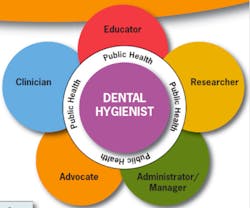Transforming Dental Hygiene Education: guiding the redefinition of dental hygienists' education and practice
It is thought that setting for practice will change, to include more dental hygienists in: hospitals; nursing homes; residential facilities for the elderly, disabled, children, mentally ill; correctional facilities; community health centers, school based health centers; rural health centers; nursery centers, centers, school and head start, job training camps, and physician or nurse practioner facilities. Dental hygienists will continue to serve populations with problems accessing care, and those with poverty level incomes, as well as people residing in dental health and professional shortage areas.(8)
Examples of these expanded roles are the Registered Dental Hygienists in Alternative Practice (RDHAP) in California, and the Expanded Practice Dental Hygienists (EPDH) in Michigan and Oregon. Dental hygienists in New Mexico can own and manage a collaborative dental hygiene practice. The new Minnesota Dental Therapist was discussed; the two models that now exist in the state are the Dental Therapist (DT) and the Advanced Dental Therapist (ADT).(9) Different levels of education and different scopes of practice exist for the two models.









